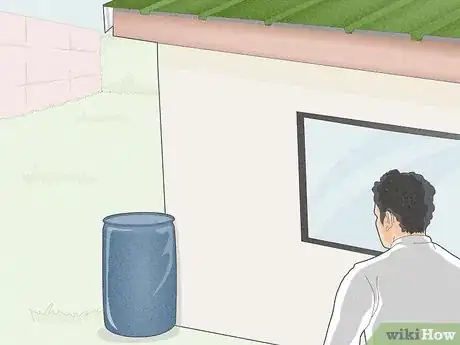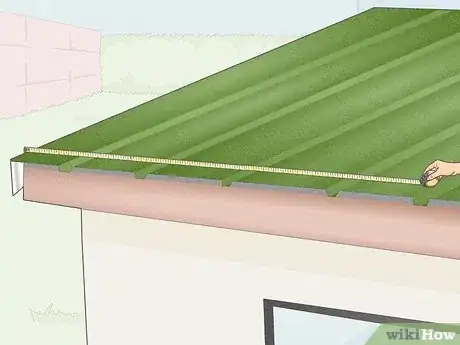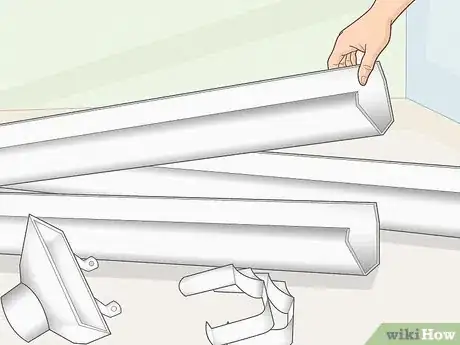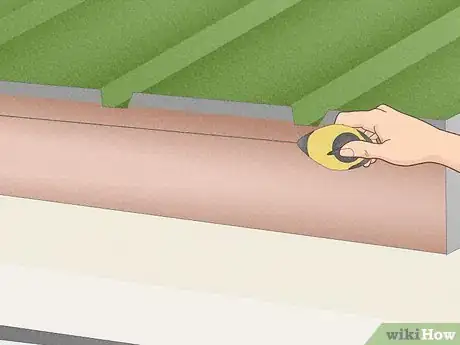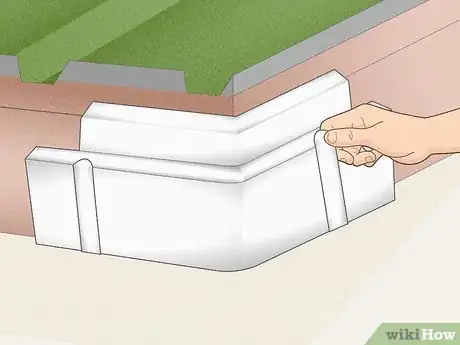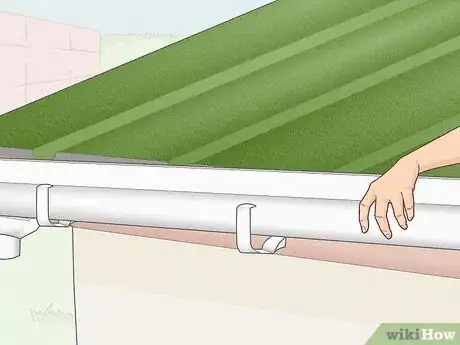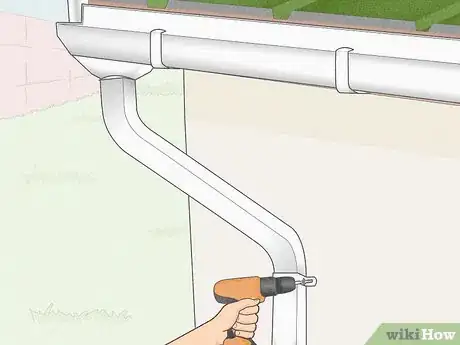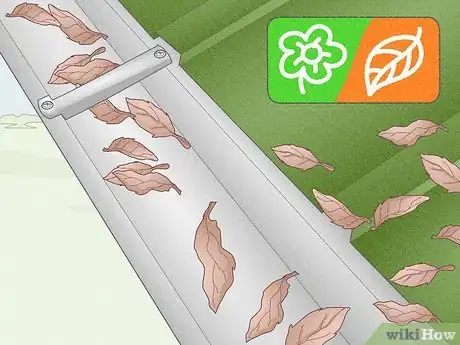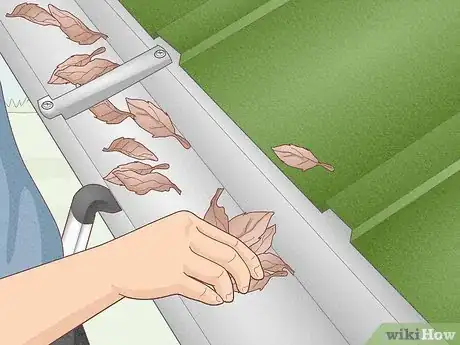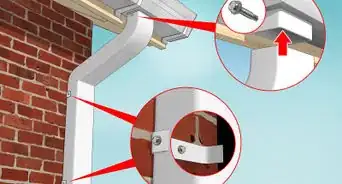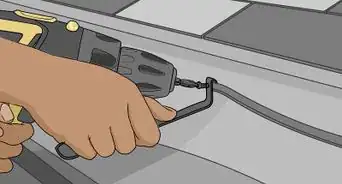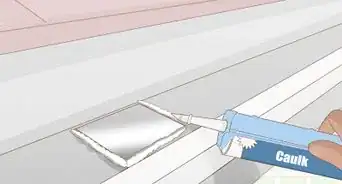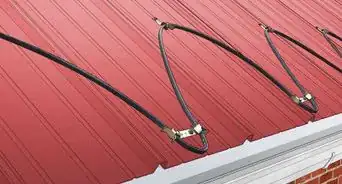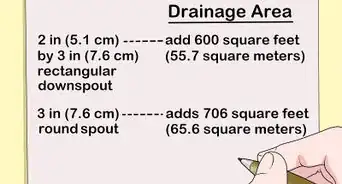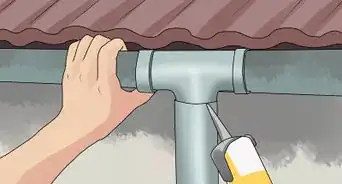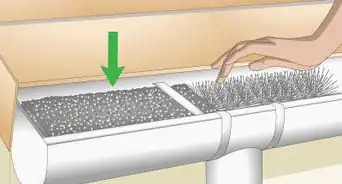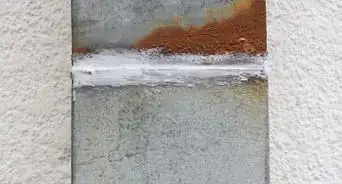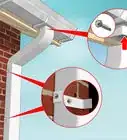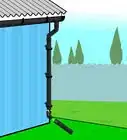This article was co-authored by Barry Zakar. Barry Zakar is a professional handyman and the founder of Little Red Truck Home Services based in the San Francisco Bay Area. With over ten years of experience, Barry specializes in a variety of carpentry projects. He is skilled at constructing decks, railings, fences, gates, and various pieces of furniture. Barry also holds his MBA from John F. Kennedy University.
There are 8 references cited in this article, which can be found at the bottom of the page.
wikiHow marks an article as reader-approved once it receives enough positive feedback. In this case, 85% of readers who voted found the article helpful, earning it our reader-approved status.
This article has been viewed 246,581 times.
Extreme amounts of water can do more than damage your roof. It can harm the siding and foundation of your house. The best way to protect siding and foundation is to install gutters[1] to direct the flow of water away from the house. Gutters can be made from many materials, including wood, steel, aluminum and copper. An increasingly popular and durable type of gutter is vinyl. Vinyl gutters are inexpensive and easy to use and to install. See Step 1 for more instructions.
Steps
Preparing for Installation
-
1Decide where you want the water to go. Are you going to collect in a rain barrel or dump your runoff far enough from your foundation to avoid leaking issues? Consider the orientation and the landscape of your home to decide what you want to happen to all the water you're sloping off your roof before you plan for gutters to take it there.
- You want water to run at least 10 feet (3.0 m) off into the yard away from the foundation of the house if you're going to dump it using downspouts.[2] Is there sufficient room for this in your yard? You also need to make sure there aren't severe slopes or ruts in the ground that angle back into your foundation, which could result in water damage in your basement.
-
2Measure out the gutter run. To determine how many gutter sections and accessory pieces you need to buy, measure the length of the house that will include gutters. This measurement is called the gutter run.[3]
- It may be easier to do a rough measurement from the ground, but to be sure hop on a ladder and get a partner to help you measure the correct sections. You want to be sure.
- Sketch a layout for the gutter installation plan to take with you to the store. Include a rough description of the shape with the correct measurements for easy consultation.
Advertisement -
3Choose between a vinyl gutter kit or separate parts. At most home repair stores, you can buy an all-in-one installation kit (or several) that will include all necessary connectors, corners, caps, and gutter pieces to make the job much easier. These kits tend to be more expensive, so if you want a more customizable and cheaper project, you'll probably want to buy the parts piecemeal.[4]
- If you decide to buy piece by piece, plan on buying 10-foot (3.048 m) lengths to cover the vinyl gutter run. If you end up with extra, you can shape it to your needs. It's better to have too much and not have to go back to the store.
- You'll also need connectors, corners, end caps, and a gutter hanger for every 2 feet (0.6 m) of gutter.
- You'll need drainpipe, elbows, hangers and outlets for every 30 (9.14 m) to 35 feet (10.67 m) for the downspouts. If you're unsure about which parts to use, talk to a salesman at your home repair store, or consult one of the DIY kits for the parts list and use it as a guide.
-
4Mark the slope on fascia boards with a chalk line. When you're up there installing, you don't want to have to measure every ten seconds. Before you start, mark the slope angle for the water to run with a chalk line to make the job much easier. Slope the vinyl gutters approximately 1/4 to 1/2 inch (0.6 to 1.3 cm) for every 10 feet (3.048 m) of gutter for short runs of less than 30 feet (9.14 m).
- Gutters need a slight slope so that water will flow out of them and not create pools of water. Place the highest point in the middle of the run, sloping in either direction by the same amount for longer runs of more than 30 feet (9.14 m).
- For gutter runs longer than 40 feet (12.2 m), consider sloping the gutters down from each end into a single downspout located at the middle of the run, in essence making a "reverse slope." Consider what will work best with your home before ordering parts and drawing your sketch.[5]
Installing Gutters
-
1Install downspout outlets on the edges of the house. Use a drill or powered screwdriver to attach the outlets using 1.25-inch (3.2 cm) deck screws. The gutters themselves will attach to these outlets, so it's important to place them first to use as a guide as you continue installing.
-
2Attach gutter hangers along the chalk line on the fascia boards. Install deck screws every 2 feet (0.6 m), approximately an inch away from the edge of the roof.
-
3Secure gutter corners on the corners of the house that will not have downspouts. The water needs to be able to travel easily through the gutters, funneling toward the downspouts. You probably won't want to have spouts at every corner, so use gutter corners in the in-between areas.
-
4Hang the gutter sections. First, install the gutter sections into the outlets, using the hangers to support the individual sections. Use a plastic slip joint at the end of every 10-foot length, connecting the gutter sections for each section with connectors. Add an end cap to areas that won't have outlets to keep the water flowing toward the downspouts.[6]
- If you need to adjust the size of the gutter sections to fit your walls, cut them using a loppers or a table saw.
- To make the job easier, have one person hold one end of the gutter while the other takes the other end and begins attaching the vinyl gutter to the hangers from the outside in.
-
5Attach drain pipes to the house. First, secure the downspout outlet to the gutter. Connect downspout elbows to the outlet and outlet tube coming from the gutter. Secure the correct size drainpipe section to fit between the elbows.[7]
- Secure the drainpipe to the wall using the same brackets you used for the gutter sections.
-
6Fit gutter guards or jackets on. Often kits will come with jackets made of metal mesh to fit over the vinyl gutters to complete the gutter installation. This keeps debris from clogging up gutters and should keep the water flowing smoothly.
Maintaining Gutters
-
1Clean gutters once in the spring and once in the fall. Maintaining an annual schedule of gutter cleanings will ensure that your system is functional when you'll need it most and you won't have to worry about emergency repairs in the middle of a big deluge. Remember to pencil in regular cleanings onto your calendar and the job won't need to take more than a few hours.[8]
- Installing gutter guards can cut down on your need for frequent cleanings.[9]
-
2Get the leaves out. The biggest problem affecting vinyl gutters is getting them cluttered and clumped with leaves during the autumn. Work your way around the house carefully on a ladder and remove any clumps of leaves and twigs that have accumulated and might be keeping water from flowing properly.
- Always work from a ladder and never from the roof. It may seem easier to climb up on the roof and avoid repositioning the ladder every couple of feet, but it's dangerous to be that near the edge, leaning over into the gutter. Take the safe out and work from the ground on a ladder with a spotter to help.
- Don't neglect the downspout. When you're finished with the gutters lining the roof, also remove large debris from the downspout as well.
-
3Flush the gutters. Using a hose, run some water through with a hose, using a gutter-cleaning attachment if you have one, to clear out any remaining debris you might have missed.
- If you've been having clogging troubles, or suspect you might have leaks, have a partner flush the sections of the gutter while you walk around and look for drips, leaks, or places the water builds up and won't drain. Reconnect loose sections or fix them with roofing screws or other fasteners to keep the gutters working well.
Warnings
- Do it yourself gutter installation kits are sold in sectional systems. Sectionals aren't as waterproof as seamless gutters.⧼thumbs_response⧽
Things You'll Need
- Extension ladder that reaches at least 3 feet (0.9 m) above the edge of your roof
- Tape measure
- Chalk line
- Powered screwdriver or cordless drill
- 1.25-inch deck screws
- Hacksaw or reciprocating saw
- Vinyl gutter kit or the following items:
- Gutter sections for gutter run you measured
- Inside or outside corners one for every corner without a downspout
- Connectors
- End caps
- Downspout outlets
- Downspout elbows
- Drainpipe and hangers
- Gutter guards
References
- ↑ https://www.thisoldhouse.com/ideas/all-about-gutters
- ↑ https://www.thisoldhouse.com/ideas/spring-flood-watch
- ↑ https://www.thisoldhouse.com/ideas/how-to-size-gutters-and-downspouts
- ↑ https://www.thisoldhouse.com/ideas/all-about-gutters
- ↑ http://www.thisoldhouse.com/toh/how-to/step/0,,442134,00.html
- ↑ http://www.sleekhome.com/topics/show/25529
- ↑ https://www.familyhandyman.com/roof/gutter-repair/how-to-install-gutters/
- ↑ https://www.foxnews.com/real-estate/how-to-clean-your-gutters-before-they-clean-out-your-wallet
- ↑ Barry Zakar. Handyman. Expert Interview. 16 July 2020.
About This Article
To install vinyl gutters, you’ll need to start by installing downspout outlets on the edges of your house, so water can drain properly from the gutters. Then, secure gutter hangers along your house and fit the gutter sections into them. Next, attach drainpipes to carry water from the downspout outlets to the ground and away from your house. Finally, fit gutter guards or jackets over the gutters to keep them free from debris. For tips on how to maintain your gutters after installation, scroll down!
